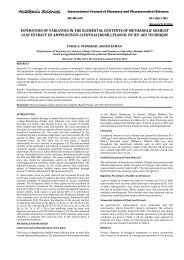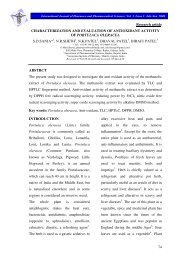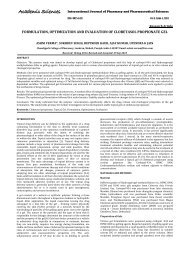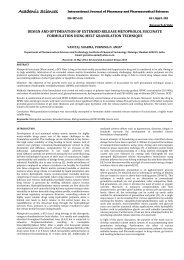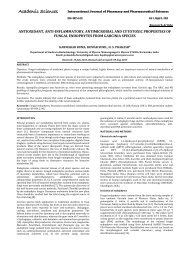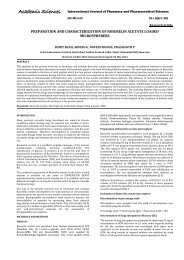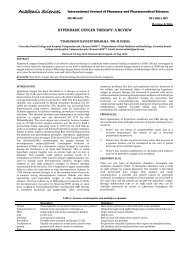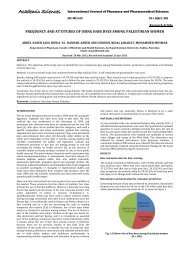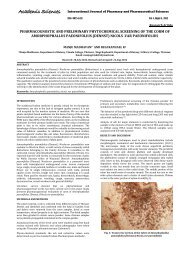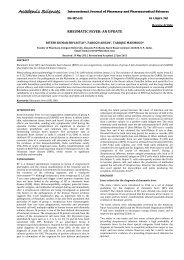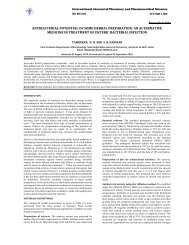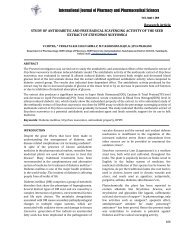optimization of lyophilization cycles for gemcitabine - International ...
optimization of lyophilization cycles for gemcitabine - International ...
optimization of lyophilization cycles for gemcitabine - International ...
You also want an ePaper? Increase the reach of your titles
YUMPU automatically turns print PDFs into web optimized ePapers that Google loves.
Academic Sciences<br />
OPTIMIZATION OF LYOPHILIZATION CYCLES FOR GEMCITABINE<br />
SREEDHAR BANDARI *1 DR. M. SESHASAI 2 AND DR. YELURI RAMA CHANDRA REDDY 3<br />
Research Article<br />
1 Sreedhar Bandari, Research Scholar, Research & Development cell, Department <strong>of</strong> Pharmaceutical Sciences, Jawaharlal Nehru<br />
Technological University, Kukatpally, Hyderabad, Andhra Pradesh, India 500085, 2 Dr. M. Seshasai, Director, Department <strong>of</strong> Formulation<br />
research & development, Dr Reddy’s Laboratories Limited, Hyderabad, Andhra Pradesh, India, 500085, 3 Dr. Yeluri Rama Chandra Reddy,<br />
SRC Laboratories (P) Ltd., Hyderabad, Andhra Pradesh, India. Email: sreebandari@yahoo.co.in<br />
ABSTRACT<br />
Received: 07 Jan 2013, Revised and Accepted: 27 Feb 2013<br />
Lyophilization also known as freeze drying is a process in which water is removed from a product after it was frozen and placed under a vacuum,<br />
allowing the ice to change directly from solid to vapor without passing through a liquid phase. The process consists <strong>of</strong> three separate, unique, and<br />
interdependent processes; freezing, primary drying (sublimation), and secondary drying (desorption). The objective <strong>of</strong> study is Gemcitabine<br />
different <strong>for</strong>mulations used to Optimization <strong>of</strong> Lyophilization <strong>cycles</strong> and the main focus is to minimize consistently drying times, while maintaining<br />
constant Gemcitabine product quality.<br />
Methods: The various <strong>for</strong>mulations were studied <strong>for</strong> thermal events by DSC technique, Impedance & DTA analysis. These parameters were<br />
determined on sample solution using Lyotherm2 analysis. By collaborated observations from Impedance, DTA <strong>of</strong> drug solution and set vacuum data<br />
from the Operation manual <strong>of</strong> Freeze dryer, <strong>lyophilization</strong> parameters <strong>for</strong> Gemcitabine <strong>for</strong> Injection were developed.<br />
Results: The data obtained from Impedance & DTA analysis <strong>of</strong> drug solution was used to determine set temperature to be used during freezing,<br />
primary drying and secondary drying set temperatures. The set vacuum <strong>for</strong> the chamber during the primary drying and secondary drying was<br />
determined from the Operation manual <strong>of</strong> Martin Christ Gefriertrocknungsanlagen GmbH Freeze dryer. The optimized cycle was about 57 hrs used<br />
<strong>for</strong> better productivity. Evaluated the lyophilized product <strong>for</strong> water content and assay. Pharmaceutical equivalence study was conducted <strong>for</strong><br />
Gemcitabine <strong>for</strong> injection with innovator product (Gemzar).<br />
Conclusion: Finally concluded that the present developed lyo cycle was used to execute the Gemcitabine <strong>for</strong> Injection product.<br />
Keywords: Gemcitabine Hydrochloride, Lyophilization cycle, Impedance, DTA analysis, Poor thermal stability, Freezing, Primary drying, Secondary drying.<br />
INTRODUCTION<br />
The chemical name <strong>for</strong> Gemcitabine Hydrochloride is 2'-deoxy-<br />
2', 2'-difluorocytidine monohydrochloride (ß-isomer). Molecular<br />
<strong>for</strong>mula is C9H11F2N3O4.HCl. Gemcitabine Hydrochloride is a<br />
white or almost white powder. It is soluble in water, slightly<br />
soluble in methanol, and practically insoluble in alcohol and<br />
polar organic solvents. PKa is 3.6. pH <strong>of</strong> the solution is between<br />
2.0 and 3.0. Gemcitabine bulk solution has poor thermal<br />
stability, hence the product was lyophilized. The input drug<br />
substance and excipients, Mannitol and Sodium acetate are<br />
White (or) white to <strong>of</strong>f white in color. Hence the product<br />
obtained is white to <strong>of</strong>f white lyophilized powder. Unit<br />
operations involved in manufacturing <strong>of</strong> Gemcitabine <strong>for</strong><br />
injection are Bulk Solution preparation, Sterilization, Filling,<br />
Lyophilization, Visual inspection & packing.<br />
Of all pharmaceutical unit operations, the highest manufacturing<br />
costs arise from drying processes. Lyophilization is the most<br />
expensive <strong>of</strong> all drying operations, both in capital investment and in<br />
operation expenses. In this context the main focus in Optimization <strong>of</strong><br />
Lyophilization (process development) is to minimize consistently<br />
drying times, while maintaining constant product quality [1].<br />
Obviously the primary drying step should be carried out at the<br />
highest temperature possible, which is limited by the so called<br />
“maximum allowable temperature”. This temperature indicates the<br />
eutectic temperature <strong>for</strong> a solute that crystallizes during freezing or<br />
the “collapse temperature” <strong>for</strong> a system that remains amorphous.<br />
There<strong>for</strong>e process control means control <strong>of</strong> the product temperature<br />
vs. time pr<strong>of</strong>ile during <strong>lyophilization</strong> [2]. To reach this goal the<br />
balance between heat and mass transfer which determines the<br />
product temperature must be more or less equal Heat and mass<br />
transfer are also key issues during scale-up <strong>of</strong> <strong>lyophilization</strong><br />
processes. Differences in (1) the degree <strong>of</strong> super cooling between<br />
laboratory, pilot and manufacturing plants, (2) heat transfer owing<br />
to differences in dryer design, and (3) the efficiency in the condenser<br />
or refrigerator system can result in substantial heterogeneity in<br />
sublimation rates and/or desorption rates and hence variation in<br />
drying time .<br />
<strong>International</strong> Journal <strong>of</strong> Pharmacy and Pharmaceutical Sciences<br />
ISSN- 0975-1491 Vol 5, Issue 2, 2013<br />
For optimum process control an indicator <strong>for</strong> the end <strong>of</strong> primary drying<br />
is needed, because an increase in shelf temperature be<strong>for</strong>e all vials have<br />
completed primary drying carries a high risk <strong>of</strong> collapse <strong>of</strong> the product.<br />
Some well-established methods <strong>for</strong> distinguishing between primary and<br />
secondary drying are available, such as commonly-used thermocouples,<br />
the pressure rise test, manometric temperature measurements or<br />
comparative pressure measurement. New investigations in modern<br />
process control have also been made. Near-infrared spectroscopy, mass<br />
spectrometry and a remote electrode system are some examples<br />
representing a growing research area.<br />
MATERIALS AND METHODS<br />
Materials<br />
Gemcitabine Hydrochloride was generously supplied as a gift sample<br />
by Dr.Reddy’s Laboratories Limited, (Hyderabad, India). Mannitol<br />
supplied by Merck, (Hyderabad, India. All other chemicals were <strong>of</strong><br />
analytical reagent grade and were used as received.<br />
Methods<br />
Pre<strong>for</strong>mulation [3, 4, 5, 6 & 7]<br />
Standard calibration curve <strong>of</strong> Gemcitabine Hcl<br />
A stock solution <strong>of</strong> (2 ppm) <strong>of</strong> standard drug was prepared, later<br />
required dilutions were made with diluent. The standard<br />
chromatogram <strong>of</strong> Gemcitabine Hydrochloride showed in Figure and<br />
plotted graphically the calibration curve.<br />
Compatibility studies<br />
In the present study the thermal events were recorded on<br />
Differential scanning instrument used model DSC Q 1000 V 9.4,<br />
Build 287. Modulated DSC method is a technique used to determine<br />
small heat flows resulting from various physical transitions <strong>of</strong><br />
<strong>for</strong>mulation components.<br />
DSC conditions:<br />
Temperature: Equilibrate at -70.0°C
Nitrogen flow: 50m/min<br />
Heating rate: 5°C/min<br />
Sample Qty: 20 µl<br />
Pan: Hermetically sealed Aluminum pan<br />
Sampler: Auto Sampler.<br />
Preparation <strong>of</strong> Gemcitabine <strong>for</strong> injection [8]<br />
Weigh accurately Mannitol and Sodium acetate anhydrous <strong>for</strong> batch<br />
size and dissolved in 80% <strong>of</strong> water <strong>for</strong> injection. Mix the solution until<br />
to get clear solution by using mechanical stirrer. Add and dissolve<br />
Gemcitabine hydrochloride (40mg/mL) concentration in the above<br />
solution and mix until to get uni<strong>for</strong>m solution. The pH <strong>of</strong> the bulk<br />
solution was adjusted with diluted sodium hydroxide and diluted<br />
Hydrochloric acid and the volume made up to required volumes.<br />
Lyotherm2 Analysis [9, 10, 11]<br />
Lyotherm2 is a thermal analyzer containing cells <strong>for</strong> measuring both<br />
solution impedance (ZSinφ) against temperature, and exothermic or<br />
endothermic changes observed as a solution freezes, melts or<br />
s<strong>of</strong>tens using differential thermal analysis (DTA). Gemcitabine vial<br />
sample was analyzed using Lyotherm2.<br />
DTA analysis using the Lyotherm2<br />
Differential thermal analysis was carried out on the <strong>for</strong>mulations to<br />
below -150.0°C according to standard procedure. The temperature<br />
<strong>of</strong> the sample together with the temperature <strong>of</strong> the reference<br />
material (AnalaR water) was measured at 5-second intervals during<br />
cooling and warming. Raw data was exported directly to Micros<strong>of</strong>t<br />
Excel <strong>for</strong> graph plotting, and interpretation <strong>of</strong> the warming pr<strong>of</strong>ile <strong>of</strong><br />
each analysis carried out to determine the temperatures <strong>of</strong> the<br />
significant events, which could be attributed to thermal changes<br />
occurring in the solutions.<br />
Impedance analysis using the Lyotherm2<br />
Impedance analysis was carried out <strong>for</strong> the <strong>for</strong>mulations to below -<br />
150.0°C according to standard procedure. Impedance <strong>of</strong> the<br />
<strong>for</strong>mulation was measured at 5secs intervals during cooling and<br />
warming. The data was exported directly to Micros<strong>of</strong>t Excel <strong>for</strong><br />
graph plotting and interpretation <strong>of</strong> the warming pr<strong>of</strong>ile <strong>of</strong> the<br />
analysis carried out to determine the temperatures <strong>of</strong> the significant<br />
events, which could be attributed to increases in ionic mobility<br />
within the <strong>for</strong>mulations.<br />
Vapour pressure [12, 13]<br />
Vapor pressure is the pressure <strong>of</strong> a vapor in equilibrium with its nonvapor<br />
phases. All liquids and solids have a tendency to evaporate to a<br />
gaseous <strong>for</strong>m, and all gases have a tendency to condense back into<br />
their original <strong>for</strong>m (either liquid or solid). Ice vapor pressure data<br />
provides minimum vapor pressure needed over ice at set temperature,<br />
to prevent melt back <strong>of</strong> ice. Ice vapor pressure data <strong>of</strong> Gemcitabine<br />
bulk solution was collected from Operation manual <strong>of</strong> Martin Christ<br />
Freeze dryer is tabulated in table 4.<br />
Lyophilization cycle development [14, 15, 16, 17, 18, 19]<br />
Based on the observations from the Lyotherm2 Analysis data and<br />
Vapor pressure data set the freezing, primary drying and secondary<br />
drying parameters <strong>for</strong> <strong>lyophilization</strong> cycle development.<br />
Freezing<br />
Minimum freezing temperature <strong>of</strong> product should be set based on<br />
Lyotherm2 Analysis data and the chamber shall be at atmospheric<br />
pressure. The freezing step shall comprise <strong>of</strong> four set points:<br />
Temperature <strong>for</strong> beginning <strong>of</strong> ice <strong>for</strong>mation<br />
Temperature <strong>for</strong> stabilization <strong>of</strong> frozen material<br />
Temperature <strong>for</strong> completion <strong>of</strong> freezing<br />
And temperature <strong>for</strong> extra freeze step to ensure that the product<br />
reaches a temperature at least 35°C.<br />
Bandari et al.<br />
Primary drying<br />
Int J Pharm Pharm Sci, Vol 5, Issue 2, 216-221<br />
The shelf temperature in primary drying shall be ramp up from at<br />
optimize temperature in six steps. The chamber vacuum would be<br />
set at optimized range. This vacuum is derived from ice vapour<br />
pressure data at optimized temperature, which is the minimum<br />
temperature required <strong>for</strong> freezing the product.<br />
Secondary drying<br />
Secondary drying <strong>of</strong> the product shall be done at set temperature<br />
based on Lyotherm2 Analysis data. The vacuum <strong>of</strong> the chamber at<br />
secondary drying shall be increased or reduced. The minimum<br />
duration <strong>of</strong> secondary drying shall be 360 minutes. This step is<br />
provided as a process control to ensure adequate drying.<br />
Water content<br />
After completion <strong>of</strong> <strong>lyophilization</strong> cycle, five vials were taken from<br />
each corner <strong>of</strong> bottom, middle, top shelf and sampling point was<br />
taken from middle <strong>of</strong> each bottom, middle, top shelf and collected<br />
samples were analyzed <strong>for</strong> water content analysis.<br />
Sampling Locations from each shelf<br />
Assay <strong>of</strong> Gemcitabine<br />
Weigh accurately 57.0 mg <strong>of</strong> Gemcitabine Hydrochloride Working<br />
Standard into a 250 ml volumetric flask, dissolve and dilute to<br />
volume with water and mix.<br />
Chromatographic Conditions<br />
Mobile phase: Dissolved 13.8 g <strong>of</strong> monobasic sodium phosphate<br />
and 2.5ml <strong>of</strong> phosphoric acid in 1000ml <strong>of</strong> water. (Note: pH <strong>of</strong> the<br />
solution is between 2.4 and 2.6)<br />
Column: C8, 4.6 mm x 250 mm column, 5µ (Zorabax or equivalent)<br />
Flow rate: 1.2 ml / minute.<br />
Wavelength: 275 nm.<br />
Temperature: Ambient.<br />
Load: 20 µl.<br />
Run time: 20 minutes<br />
Calculate Gemcitabine assay % =<br />
Where,<br />
At = Peak area due to Gemcitabine in Sample preparation,<br />
As = Peak area due to Gemcitabine in Standard preparation,<br />
Sw = Weight <strong>of</strong> Gemcitabine Hydrochloride Working Standard taken<br />
in mg,<br />
P = Purity <strong>of</strong> Gemcitabine Hydrochloride Working Standard used.<br />
LC = Label claim<br />
RESULTS & DISCUSSION<br />
Standard calibration curve <strong>of</strong> Gemcitabine Hcl<br />
The absorbance <strong>of</strong> different concentrations <strong>of</strong> solution was<br />
measured at respective wave length <strong>of</strong> maximum absorbance, using<br />
UV detector. Absorbance values were plotted against respective<br />
concentration to obtain standard calibration curve. The standard<br />
chromatograph <strong>of</strong> Gemcitabine Hcl was shown in figure1.<br />
217
Compatibility studies<br />
There was no significant difference in the drug-excipients mixture,<br />
which confirmed the absence <strong>of</strong> any chemical interaction between<br />
the drugs and other excipients. The interpretation was shown<br />
graphically in figure 2.<br />
Preparation <strong>of</strong> Gemcitabine <strong>for</strong> injection<br />
Prepared Gemcitabine <strong>for</strong> injection bulk solution with optimized API<br />
and excipients concentrations. The ingredients concentrations were<br />
described in table 1.<br />
Lyotherm2 Analysis<br />
Gemcitabine <strong>for</strong> Injection bulk solution 25mL solution was filled into<br />
vial and sample was analyzed using Lyotherm2.<br />
DTA analysis using Lyotherm2<br />
The Gemcitabine bulk solution was analyzed <strong>for</strong> thermal attributes.<br />
Analytical results revealed that minimum temperature <strong>of</strong> -30°C is<br />
required to freeze the Gemcitabine bulk solution. The data obtained<br />
AU<br />
0.050<br />
0.040<br />
0.030<br />
0.020<br />
0.010<br />
0.000<br />
-0.010<br />
Cytosine - 2.637<br />
Gemcitabine - 7.626<br />
Bandari et al.<br />
Int J Pharm Pharm Sci, Vol 5, Issue 2, 216-221<br />
from DTA analysis <strong>of</strong> drug solution was used to determine set<br />
temperatures to be used during freezing, primary drying and <strong>for</strong><br />
secondary drying. Results were shown graphically in figure2 and<br />
observations were mentioned in table2.<br />
Impedance analysis using the Lyotherm2<br />
The Gemcitabine bulk solution was analyzed <strong>for</strong> impedance.<br />
Analytical results revealed that minimum temperature <strong>of</strong> -30°C is<br />
required to freeze the Gemcitabine bulk solution. The data obtained<br />
from DTA analysis <strong>of</strong> drug solution was used to determine set<br />
temperatures to be used during freezing, primary drying and <strong>for</strong><br />
secondary drying. Results were shown in figure and observations<br />
were mentioned in table. Results were shown graphically in figure3<br />
and observations were mentioned in table3.<br />
Ice vapor pressure data was collected from Operation manual <strong>of</strong><br />
Martin Christ Freeze dryer is tabulated in table-6.25. From this data<br />
during sublimation minimum vacuum <strong>of</strong> 0.37 mbar is necessary at a<br />
product temperature <strong>of</strong> -30°C. Hence vacuum set point at start <strong>of</strong><br />
primary drying can be 0.37 mbar. The pressure data was shown in<br />
table 4.<br />
-0.020<br />
0.00 2.00 4.00 6.00 8.00 10.00 12.00 14.00 16.00 18.00 20.00 22.00 24.00 26.00 28.00 30.00 32.00 34.00<br />
Minutes<br />
Fig. 1: Standard chromatograph <strong>of</strong> Gemcitabine Hcl<br />
Fig. 2: Gemcitabine <strong>for</strong> injection thermal events by DSC<br />
Table 1: Optimized composition <strong>of</strong> drug and excipients <strong>for</strong> Gemcitabine <strong>for</strong> Injection<br />
S. No. Ingredients Concentration in solution mg/mL<br />
1 Gemcitabine Hydrochloride equivalent to Gemcitabine 40mg 45.5408 mg / mL<br />
2 Mannitol (Pyrogen free) 40 mg / mL<br />
3 Sodium acetate anhydrous 2.5 mg / mL<br />
4 Water <strong>for</strong> Injection q.s to 1mL<br />
218
Bandari et al.<br />
Table 2: Observations <strong>of</strong> DTA Thermo-gram<br />
Int J Pharm Pharm Sci, Vol 5, Issue 2, 216-221<br />
Type <strong>of</strong> analysis Temperature Description <strong>of</strong> events/ general comments<br />
DTA From -68.0°C to<br />
-50.0°C<br />
Exothermic (peak at -61.0°C) indicative <strong>of</strong> a stabilization / rearrangement within the frozen material.<br />
From -50°C to<br />
-30°C<br />
DTA shows that it is a frozen material.<br />
From -30.0°C<br />
to -21.0°C<br />
Endothermic (peak at -26.0°C) indicative <strong>of</strong> a stabilization within the frozen material<br />
From -20.0 °C<br />
to -5.0°C<br />
Further <strong>for</strong>mation <strong>of</strong> ice<br />
-5.0°C Possible start <strong>of</strong> ice <strong>for</strong>mation<br />
-1.0°C Ice Melt<br />
Table 3: Observations <strong>of</strong> Impedance (Zsinφ) analysis<br />
Type <strong>of</strong> analysis Temperature Description <strong>of</strong> events/ general comments<br />
Impedance<br />
(Zsinφ)<br />
DTA<br />
-74.0°C Increase In impedance curve indicative <strong>of</strong> a stabilization event<br />
-72.0°C Decrease In impedance curve indicative <strong>of</strong> a s<strong>of</strong>tening event<br />
-36.0°C Decrease In impedance gradient indicative <strong>of</strong> a s<strong>of</strong>tening event<br />
Fig. 3: Impedance and DTA analysis results <strong>for</strong> Gemcitabine solutionVapour pressure<br />
Table 4: Ice vapor pressure data<br />
Temperature Vacuum Temperature Vacuum Temperature Vacuum Temperature Vacuum Temperature Vacuum<br />
(°C)<br />
(mbar) (°C)<br />
(mbar) (°C)<br />
(mbar) (°C)<br />
(mbar) (°C)<br />
(mbar)<br />
0 6.110 -16 1.510 -34 0.250 -54 0.024 -70 0.0026<br />
-1 5.620 -17 1.370 -35 0.220 -55 0.021 -71 0.0023<br />
-2 5.170 -18 1.250 -36 0.200 -56 0.018 -72 0.0019<br />
-3 4.760 -19 1.140 -37 0.180 -57 0.016 -73 0.0017<br />
-4 4.370 -20 1.030 -38 0.160 -58 0.014 -74 0.0014<br />
-5 4.020 -21 0.940 -39 0.140 -59 0.012 -75 0.0012<br />
-6 3.690 -22 0.850 -40 0.120 -60 0.011 -76 0.0010<br />
-7 3.380 -23 0.770 -41 0.110 -61 0.009<br />
-8 3.010 -24 0.700 -46 0.060 -62 0.008<br />
-9 2.840 -25 0.630 -47 0.055 -63 0.007<br />
-10 2.560 -28 0.470 -48 0.050 -64 0.006<br />
-11 2.380 -29 0.420 -49 0.045 -65 0.0054<br />
-12 2.170 -30 0.370 -50 0.040 -66 0.0047<br />
-13 1.980 -31 0.340 -51 0.035 -67 0.0047<br />
-14 1.810 -32 0.310 -52 0.030 -68 0.0035<br />
-15 1.650 -33 0.280 -53 0.025 -69 0.003<br />
Lyophilization cycle development<br />
By corroborated observations from Impedance & DTA <strong>of</strong> drug<br />
solution and Ice vapor pressure data, the proposed cycle parameters<br />
are summarized. Graphically represented the lyo Rx value (%) vs.<br />
cumulative time (mins) in figure3.<br />
Freezing<br />
Minimum freezing temperature <strong>of</strong> product was 30°C and the Chamber<br />
vacuum shall be at atmospheric pressure. The product temperature <strong>of</strong><br />
less than -30°C shall be attained by gradually cooling the shelf from room<br />
temperature to -40°C. The freezing step shall comprise <strong>of</strong> four set points:<br />
219
– 5°C: For beginning <strong>of</strong> ice <strong>for</strong>mation.<br />
– 25°C: For stabilization <strong>of</strong> frozen material.<br />
– 40°C: For completion <strong>of</strong> freezing.<br />
– 42°C: Extra freeze step to ensure that the product reaches a<br />
temperature at least – 35°C.<br />
The above process steps would ensure that the product is at least<br />
5°C below its freezing points <strong>of</strong> – 30°C.<br />
Primary drying<br />
The shelf temperature in primary drying shall be ramped up from –<br />
40°C to +40°C in six steps. The heating rates during early steps <strong>of</strong><br />
this ramp up would be kept below 3°C per hour. This ensures a<br />
gradual heating <strong>of</strong> the product vial the vacuum would be maintained<br />
(< 0.37 millibar) such that melt back during the process does not<br />
happen.<br />
The chamber vacuum would be set at 0.37 millibar. During ramp up<br />
<strong>of</strong> shelf temperature from -40°C to +40°C, the chamber vacuum<br />
would further be reduced from 0.37 millibar to 0.035 millibar (less<br />
than 1/10 th <strong>of</strong> 0.37 millibar). This is done gradually by reducing the<br />
vacuum in a programmed manner from 0.37 millibar, to 0.25<br />
millibar, 0.2 millibar and then to 0.035 millibar. This reduction in<br />
vacuum to less than 1/10 th <strong>of</strong> 0.37 millibar is necessary, because at<br />
end <strong>of</strong> primary drying when pressure increase test is per<strong>for</strong>med, the<br />
Water content<br />
Bandari et al.<br />
Int J Pharm Pharm Sci, Vol 5, Issue 2, 216-221<br />
chamber vacuum does not increase beyond 0.37 millibar. This<br />
ensures that product does not melt back during the process.<br />
Consistent with reduction in vacuum in a programmed manner,<br />
from 0.37 millibar to 0.035 millibar ramp up <strong>of</strong> shelf temperature is<br />
sequenced as: -40°C to +20°C (< 3°C/hr), +20°C to +30°C (< 10°C hr)<br />
this is to mobilize vapour, +30°C to +35°C (
Bandari et al.<br />
Table 5: Water content values <strong>of</strong> Gemcitabine <strong>for</strong> Injection<br />
Test Specification Water content results (w/w)<br />
Gemcitabine <strong>for</strong> Injection<br />
B.No: GFI-1<br />
Int J Pharm Pharm Sci, Vol 5, Issue 2, 216-221<br />
Gemcitabine <strong>for</strong> Injection<br />
B.No: GFI-2<br />
Top Middle Bottom Top Middle Bottom<br />
Water content NMT 5.00% w/w 0.29 0.28 0.31 0.27 0.30 0.26<br />
0.31 0.29 0.39 0.33 0.27 0.37<br />
0.27 0.32 0.42 0.24 0.32 0.42<br />
0.26 0.33 0.38 0.29 0.29 0.36<br />
0.34 0.29 0.44 0.34 0.24 0.40<br />
0.29 0.25 0.37 0.29 0.31 0.37<br />
0.32 0.31 0.31 0.30 0.36 0.37<br />
0.37 0.28 0.42 0.36 0.32 0.41<br />
0.34 0.34 0.35 0.33 0.33 0.34<br />
0.36 0.23 0.38 0.35 0.26 0.38<br />
Average 0.32 0.27 0.38 0.32 0.27 0.38<br />
% <strong>of</strong> Water content <strong>of</strong> Marketed sample = 0.4<br />
Table 6: Assay results <strong>of</strong> Gemcitabine in Gemcitabine <strong>for</strong> Injection<br />
S. No. Gemcitabine <strong>for</strong> Injection batch numbers Assay (%) Marketed sample<br />
01 GFI-01 101.2 100.2%<br />
02 GFI-02 99.4<br />
03 GFI-03 100.9<br />
04 GFI-04 101.3<br />
CONCLUSION<br />
Impedance & DTA analysis were conducted on bulk solution. The<br />
data obtained from Impedance & DTA analysis <strong>of</strong> drug solution was<br />
used to determine set temperature to be used during freezing,<br />
primary drying and secondary drying set temperatures. The set<br />
vacuum <strong>for</strong> the chamber during the primary drying and secondary<br />
drying was determined from the ice vapour pressure data. By<br />
corroborated observations from Impedance & DTA <strong>of</strong> drug solution<br />
and ice vapour pressure data, the <strong>lyophilization</strong> cycle was<br />
developed. The proposed cycle was executed in batch. The<br />
operational ranges at different stages <strong>of</strong> the process were optimized.<br />
Results revealed that all the parameters are satisfactory.<br />
Pharmaceutical equivalence study was conducted <strong>for</strong> Gemcitabine<br />
<strong>for</strong> injection USP with innovator product (Gemzar). The data shows<br />
that both the products are pharmaceutically equivalent<br />
REFERENCES<br />
1. Julia Christina Kasper, Wolfgang Friess “The freezing step in<br />
<strong>lyophilization</strong>: Physico-chemical fundamentals, freezing<br />
methods and consequences on process per<strong>for</strong>mance and<br />
quality attributes <strong>of</strong> biopharmaceuticals” European Journal <strong>of</strong><br />
Pharmaceutics and Biopharmaceutics 2011; 78(2) : 248-263<br />
2. Thomas W. Patap<strong>of</strong>f and David E. Overcashier “The importance<br />
<strong>of</strong> freezing on <strong>lyophilization</strong> cycle development” Biopharm<br />
2002; 3: 16-22<br />
3. Motolas, Agharkar S. “Pre<strong>for</strong>mulation research in<br />
pharmaceutical dosage <strong>for</strong>m – Parenteral medications” Marcel<br />
Dekker Inc New York 1984; 23<br />
4. Rowe R C, Sheskey P J, Owen S C “Hand book <strong>of</strong> Pharmaceutical<br />
excipients” Pharmaceutical press London, 5 th ed 2006; 449:<br />
231 & 389<br />
5. Albert S, Kearney, Kamlesh patel, Nagesh R Palepu<br />
“Pre<strong>for</strong>mulation studies ti aid in the development <strong>of</strong> a ready to<br />
use injectable solution <strong>of</strong> the anti tumor agent, Topotecan”<br />
Int.J.Pharm 1996; 127: 229-237<br />
6. Howe A Friess W “Physico-chemical <strong>lyophilization</strong> behavior <strong>of</strong><br />
Mannitol, human serum albumin <strong>for</strong>mulations” Eur. J <strong>of</strong> Pharm<br />
Sci 2006; 28(3): 224-232.<br />
7. Cartenson JT ”Pharmaceutical Pre<strong>for</strong>mulation” Technomic<br />
publishing Co. Inc. New York 1998; 165<br />
8. Jennings TA “Effect <strong>of</strong> <strong>for</strong>mulation on <strong>lyophilization</strong>-Part I” IVD<br />
Technology 1997; 38-41<br />
9. Rey L, May JC, Editor “Freeze drying/<strong>lyophilization</strong> <strong>of</strong><br />
pharmaceutical and biological products” Marcel Dekker Inc<br />
New York 2004; 1-32<br />
10. S.L. Nail, “The Effect <strong>of</strong> Chamber Pressure on Heat Transfer in<br />
the Freeze Drying <strong>of</strong> Parenteral Solutions,” PDA J. Pharm. Sci.<br />
Technol. 1980; 34: 358–368.<br />
11. A guide to freeze drying <strong>for</strong> the laboratory, LABCONCO, An<br />
industry service publication; 1-17<br />
12. B. Nuijon, M. Bouma, H. Talsma, C. Manada, J.M Jimcno, L.<br />
Lopez-Lazaro “Development <strong>of</strong> a lyophilized Parenteral<br />
Pharmaceutical <strong>for</strong>mulation <strong>of</strong> the Investigational polypeptide<br />
Marine anti cancer agent Kahalalide” F.Drug.Dev.Ind. pharm<br />
2001; 27(8): 767-80<br />
13. Xiang J et al Investigation <strong>of</strong> freeze-drying sublimation rates<br />
using a freeze-drying microbalance technique, Int. J <strong>of</strong> Pharma<br />
2004; 279 : 95-105<br />
14. Brulls M & Rasmuson A “A heat transfer to vial <strong>lyophilization</strong>”<br />
Int. J <strong>of</strong> Pharm 2002; 246 : 1-16<br />
15. Rey L, May JC, Editor “Freeze drying/<strong>lyophilization</strong> <strong>of</strong><br />
pharmaceutical and biological products” Marcel Dekker Inc<br />
New York 2004 : 1-32<br />
16. Real time <strong>optimization</strong> <strong>for</strong> freeze drying process. Computer<br />
aided chemical engineering 2004; 18 : 595-600<br />
17. Swarbrick J, Bovlan J “Freeze drying in Encyclopedia <strong>of</strong><br />
Pharmaceutical technology” New York, Marcel Dekker Inc<br />
2001; 6.<br />
18. Wallen AJ, Van ocker SH, Sinacola JR, Phillips BR “The effect <strong>of</strong><br />
loading process on product collapse during large scale<br />
<strong>lyophilization</strong>” Pharma Sci 2008<br />
19. Gona KH, Bruttini R, Crosser OK, LIapisa AZ “Freeze drying <strong>of</strong><br />
pharmaceuticals in vials on trays: effect <strong>of</strong> drying chamber wall<br />
temperature and tray side on <strong>lyophilization</strong> per<strong>for</strong>mance” Int. J<br />
H M Tran 2005;48 :1675-87.<br />
221



